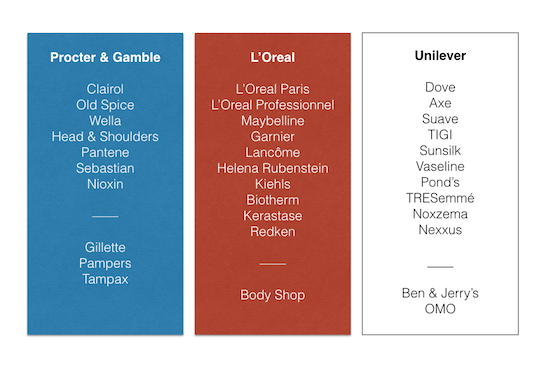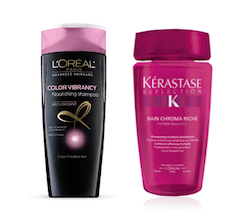Driving your brand’s point of difference
When you work for a large organization with many sub-brands, where people tend to cycle through brands as part of career advancement, it’s a fact that brand differentiation becomes hard to maintain. As a result, an evermore connected, knowledgeable and demanding customer, will become less duped and seek out different solutions outside the stable. As a point in case, in the beauty area, multinational companies Estée Lauder (Frederic Malle, Le Labo, Rodin Olio Lusso) and L’Oreal (Nyx, Neely, Carol’s Daughter) have been actively acquiring niche brands in order to compensate for the “fatigue” with their “mature” portfolio of brands.
Consumers are suffering from brand fatigue in cosmetics and fashion and are increasingly seeking out brands that are more exclusive, less well-known and not so widely distributed as big brands.”
-Reuters
For such multinationals, it is my conviction that, until the notion of brand separation and identity is emphatically solved, the addition of new niche brands will naturally follow the path of the existing mature brands. In other words, these niche brands will also be diluted and lose their edge. {Tweet this!}
Corporate Strategy versus Brand Strategy
Between best practice sharing, back office harmonizing, shared logistics and R&D and, not least, shared people, it is hard to keep brands markedly different while residing within a large corporate umbrella. The levers with which one can play to drive a brand strategy and its point of difference are often constrained by the structure and business model. I analyze company organization through three axes (and I exclude from this analysis not for profit and government):
- If the company is privately held or publicly traded
- If the umbrella corporate brand is a or the commercial brand
- If the founder or part of the founding family is present
In the cases above, there are plenty of nuances and options. Inevitably, though, each has a direct and important impact on the way a brand is developed.

Privately held or publicly traded
Generally, companies who have managed to grow without dipping into the stock market maintain a degree of freedom that can be extremely liberating for long-term brand development. Of course, if the company is privately held, but backed by private equity (depending on the variety of PE), the look & feel can correspond to a publicly traded company. However, when you observe the determined success of companies like Hermès and Chanel (and Giorgio Armani, perhaps to a lesser extent) in the luxury space, you can certainly appreciate the strength of character and single-mindedness of their brand strategy. Conversely, shareholders perceive and accept with difficulty the (long-term) efforts to build separate brands within a portfolio.
Presence of the founder or founding family
I have long held that branding gets personal. It stands to reason that if the founder is present, there is a natural embodiment of the brand via that person. Not that all founders or off-spring are perfectly suited, but there is systematically an element of emotion that a corporate CEO — even when brought up through the ranks — cannot incarnate, especially faced with shareholder pressures. When a founder (or extension) is present, there is often a greater backbone that is not beholden to strictly rational decision-making. Examples that come to mind include: Steve Jobs, Michael Dell, Howard Schultz, Richard Branson, Jeff Bezos… The real challenge for these companies becomes the succession.
Corporate or commercial umbrella brand
As far as brand structures go, there are essentially three variations:
- the corporate brand is the commercial brand: Apple
- the corporate brand is also a commercial brand: L’Oreal (commercializing L’Oreal Paris and L’Oreal Professionnel…)
- the corporate brand is an umbrella name with no commercial existence: Procter & Gamble, Unilever


There are, of course, hybrids along the scale. When you take a look at the stable of brands that are managed by conglomerates, such as P&G, L’Oreal and Unilever — which all compete in the beauty space — there is an inherent challenge to foster and distinguish the brand strategies of each sub (commercial) brand. I believe this is a highly strategic issue, driven all the more sensitive by the augmented transparency that comes with the internet. I can remember conversations, while working at L’Oreal, where senior executives wished not to let the cat out of the bag that L’Oreal owned certain other brands. It was as if it were better that the customer didn’t know. On the one hand, there was the constant “healthy” in-fighting between brands (not wanting to give extra publicity to ‘competitive’ brands). Secondly, there was the inevitable question: what is the real difference between the products, for example a L’Oreal Paris shampoo at $5 and a Kerastase shampoo at $39.
Should management embody the brand?
So, what is a conglomerate to do in order to leverage a portfolio of brands? There is no easy answer as there are indeed vast benefits to belonging to a larger structure, with an installed base of customers, having size at the negotiation table with distributors, economies of scale for industrial production, etc. However, the truth is that, in a world where information is evermore accessible about the [lack of] differences, multinationals urgently need to reinforce the differential that helps underpin the value-added pricing in premium brands. With the disintermediation and merging of distribution channels, brands can no longer hide behind segregated channels nor behind the wall of a 30-second spot.{Tweet this!} I, for one, believe that management needs to find ways for the brands to live differently within the confines of the organization. Troubling as it might be from the HR standpoint, branding must get more personal, more values oriented; and employees must be encouraged to embrace personally the brands they represent.{Tweet this!} And, I would suggest that brand management will need more managers who embrace and embody brand values and the brand strategy, much like the original founder.
Your thoughts are welcome!










